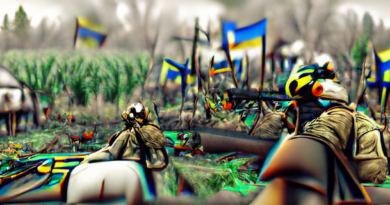Russian TV Is Filled With Images of Bucha’s Dead, Stamped With the Word “Fake”
Because the horrifying truth of what happened in Bucha, Ukraine, during the Russian occupation last month is unpalatable to officials in Moscow, the Russian government has invented a lurid fantasy to tell its own people.
For the past week, Russian television, which is under the full control of the government, has presented as fact the fictional version of events crafted by the state — that the bodies of murdered civilians discovered in Bucha last week were planted there after the Russian withdrawal. According to Russian news anchors, correspondents, and pundits, the apparent crime scene discovered after the Russian retreat was a monstrous plot to frame Russian soldiers as war criminals, carried out by Ukraine’s intelligence service and its Western partners.
To sustain the deception that the killings in Bucha happened after Russia’s four-week occupation ended, news broadcasts and discussion programs have rigorously avoided mentioning that the government’s story has been contradicted by drone footage, satellite images, and witness testimony. But the most surprising element of the coordinated effort to keep the Russian public from learning the truth is that the state television channels most Russians rely on for their news have reported incessantly on the video — showing dead bodies lining a street in the Kyiv suburb hour after hour.
Russian viewers, instead of being discouraged from seeing videos that implicate their soldiers in war crimes, have instead been forced to watch the brutal images of dead bodies lining the street of Bucha over and over — but always accompanied by conspiratorial claims that the victims were either actors, pretending to be dead, or people who were killed by Ukrainian forces after Russian forces left. In most cases, the video of more than a dozen bodies sprawled on the pavement along Bucha’s Yablonska Street was also stamped with the word “fake,” written in red letters in English and Russian.
As a result of this strategy, millions of Russians have been bombarded with images of Bucha’s dead and urged to direct their anger over the murders onto fictional Ukrainian or Western perpetrators, not the Russian soldiers who controlled the city when these civilians were gunned down.
That’s how the video of dead bodies on Yablonska Street was framed on the evening news on Russia’s Channel One. As the images that shocked the world were shown to Russian viewers last week, a news anchor in Moscow read a conspiratorial script that echoed the Russian Defense Ministry’s false claim that two of the bodies appeared to move before the clip was over, supposedly proving that the crime scene was faked with the use of actors.
On Sunday, Russian state television broadcast video of the dead in Bucha, but in a conspiratorial report that echoed false claims from defense officials in Moscow who mistakenly said two of the figures could be seen moving and so must be crisis actors just pretending to be dead. pic.twitter.com/3kTC58oMIf
— Robert Mackey (@RobertMackey) April 7, 2022
“Pay attention,” the state television anchor instructed viewers, as parts of the video were replayed in slow motion. “One extra raises his hand, another stands up, apparently deciding that he has already played his role.”
In fact, as open-source researchers explained in viral tweets, a closer look at the original video — which was posted on YouTube on April 2 by Ukraine’s Espreso TV — showed that the bodies did not move at all. What some viewers misinterpreted as a person’s arm being raised was actually a speck of water on the car windshield the video was recorded through. And what looked to others like another body sitting up was in fact a distortion of the image of that body’s reflection seen in a convex mirror on the passenger side of the car.
Getting fed up of this “it’s a moving arm” bullsh….. it’s a raindrop on the windscreen, alongside an inverted channel version for more clarity. The whole arm moving thing is just ridiculous. pic.twitter.com/ZiuEX4rFWc
— Aurora Intel (@AuroraIntel) April 3, 2022
But because access to Twitter has been blocked in Russia since last month — when independent television channels, radio stations, and websites were shuttered to keep unfiltered news about Ukraine from reaching the Russian public — most Russians who were subjected to this state television report probably remain unaware that these false claims were debunked within minutes of the broadcast. In the days that followed, the video of victims in Bucha, always labeled “fake,” played again and again on Russian state television shows dedicated to interpreting the news for the nation.
As Francis Scarr of BBC Monitoring reported, the bodies appeared on huge screens on the set of one show as the host, Olga Skabeeva, presented an updated version of the conspiracy theory: the claim that the dead bodies were not those of actors but of local residents who had welcomed the Russian occupation and were then killed by the Ukrainian army when it regained control of the city.
Olga Skabeyeva:
“The West is using Bucha to legalise future purges in areas previously occupied by the ?? army. The people were killed by ?? forces because they didn’t resist the Russians. The West is thus giving ?? approval to extrajudicially kill those they deem traitors” pic.twitter.com/CMMo7IfEyA
— Francis Scarr (@francska1) April 4, 2022
Channeling the Russian Defense Ministry’s claim that “the bodies in the video seem to have been deliberately laid out to create a more dramatic picture,” Skabeeva also told viewers that the aim of the hoax supposedly staged by Ukraine and its Western allies was to create a “fake version of Srebrenica.”
Russian state TV’s Olga Skabeyeva on Bucha this morning:
“A flagrantly brutal provocation by Ukrainian Nazis”
Zelensky and “absolutely the whole allegedly civilised West are attempting to create a hybrid, fake version of Srebrenica” pic.twitter.com/auJIgPDhSe
— Francis Scarr (@francska1) April 4, 2022
The images of Bucha’s massacred civilians also played on a large screen last week behind Olesya Loseva, the host of “Time Will Tell,” which is described by the state broadcaster as a “sociopolitical talk show about what worries every Russian.”
Loseva told viewers that the Western-directed hoax had been staged in Bucha because U.S. President Joe Biden had recently called his Russian counterpart, Vladimir Putin, “a butcher.” The Ukrainian city’s name, Loseva explained, sounds like the English word “butcher.”
This ridiculous conspiracy theory has now been picked up by Russian TV
Talk show host Olesya Loseva suggests that Bucha was chosen for the West’s “egregious accusation against Russia” because Biden recently called Putin a “butcher”, so the word “should be clear to Americans” https://t.co/PZwUmHtKXK pic.twitter.com/uQcsupiHlC
— Francis Scarr (@francska1) April 4, 2022
The footage was still playing on a loop behind Loseva as she handed the floor to a guest, Gevorg Mirzayan, who teaches politics at Moscow’s Financial University. Mirzayan suggested that the staging of the fake crime scene in Bucha was probably done by British intelligence agents.
Pundit Gevorg Mirzayan on Bucha:
“This was done by professionals, probably British. They’re the best in the area of information operations. [They know how] to place the bodies correctly, do everything correctly, create a nice picture for the necrophilic Western consciousness” pic.twitter.com/vMNQxZFnHC
— Francis Scarr (@francska1) April 4, 2022
In 2018, the British government accused Russia of poisoning Sergei Skripal, a former Russian-British double agent living in England, with “a military-grade nerve agent.” Russia’s Foreign Ministry responded by claiming that British spies might have poisoned Skripal as part of a plot to tarnish Russia’s reputation ahead of the World Cup soccer tournament it was preparing to host that summer.
A month later, Russia’s foreign minister, Sergey Lavrov, claimed Russia had “irrefutable evidence” that British agents had directed the staging of a chemical attack in the Syrian town of Douma, which Russian officials insisted was a hoax intended to frame the Syrian government forces it was fighting alongside. Russia produced no evidence for that claim.
“Antifake” Is on the Case
Images of the supposed hoax at Bucha were also analyzed on “Antifake,” a new show that suddenly appeared last month as the Russian invasion of Ukraine stalled in the Kyiv suburbs, including Bucha. According to the state broadcaster, the show’s educational mission is to help viewers “distinguish lies from truth” in social media clips from Ukraine. “Videos that cause you a flurry of emotions, may, in fact, turn out to be soullessly and cynically manufactured fakes,” the show’s producers say. “Experts at ‘Antifake’ are sorting it out.”
The “Antifake” logo, prominently featured on its set, is an illustration of what seems at first to be a rabbit ready to be pulled from a hat, until the image is flipped upside down to reveal that it is actually a villainous con man in a top hat. That the drawing of the man’s features seems to echo anti-Semitic propaganda also connects it to a long tradition of virulent conspiracy theories.
The “Antifake” logo’s reference to a magic trick seems to be an unsubtle way of suggesting to viewers that they need to be wary of believing any images from social media or foreign news reports, which could be illusions designed to fool them. The irony seems to be lost on the producers that by using the show to trick Russian viewers into believing that genuine video of atrocities in Ukraine is fake, “Antifake” is itself part of a hoax.
The host of “Antifake,” Alexander Smol, introduced the episode on Bucha by telling viewers that the images from the town, which look like something from a horror movie, “are being cynically portrayed as Russian forces’ cruelty” as part of a Ukrainian and Western “infowar.” A rapid-cut montage then flashed up on screen, mixing images of the bodies with the show’s logo, set to menacing music.
An episode of the Russian state TV show “Antifake” this week was dedicated to arguing that the Bucha massacre was a hoax. In other words, a show that claims to help Russian viewers see through hoaxes is itself part of a hoax. pic.twitter.com/5jEnNfu0Xy
— Robert Mackey (@RobertMackey) April 9, 2022
After introducing his guests, Smol then screened video of the bodies on Yablonska Street, with the word “fake” in English and Russian written across the images.
One “Antifake” guest, Alexander Artamonov, the former editor of a government radio station, then echoed the Russian Defense Ministry’s claim that the scene was staged, observing that it looked to him as if the bodies had been carefully laid out for the media. No mention was made of the evidence, from satellite images and drone video, that the bodies on Yablonska Street were in those precise locations weeks before the Russian forces withdrew from Bucha.
As a guest on the Russian state television show “Antifake” argued that the Bucha massacre was a hoax, video and photographs of the victims, including images from @AP and @AFP journalists, were labeled “Fake” in the background pic.twitter.com/5U8eInhXQh
— Robert Mackey (@RobertMackey) April 10, 2022
As Artamonov spoke, video and photographs of the victims in Bucha recorded by Associated Press and Agence France-Presse journalists were also stamped “fake” in the background. This week, Russia’s Foreign Ministry spokesperson, Maria Zakharova, angrily accused “Western and primarily the U.S. media of not only spreading fake news and disinformation, but of being an accomplice in the massacre in Bucha.”
? Russian MFA Spokeswoman Maria #Zakharova on the situation in #Ukraine:
? I am accusing Western and primarily the US media of not only spreading #fakenews and disinformation, but of being an accomplice in the massacre in Bucha.
The truth will always prevail. pic.twitter.com/tchimy0lWi
— MFA Russia ?? (@mfa_russia) April 7, 2022
Zakharova went on to claim that correspondents from the West who reported evidence that the Bucha victims were, in fact, killed during the Russian occupation were akin to Nazi propagandists who knowingly exaggerated a Red Army massacre of dozens of German civilians in East Prussia in 1944. Then she suggested that massacres carried out in recent decades by Russia’s Serbian and Syrian allies were also hoaxes staged by Western authorities. “Wasn’t it the same in Srebrenica?” Zakharova asked, according to an official transcript. “Or in Aleppo and Douma in Syria? Absolutely the same. Who is paying for this? The sponsors are Washington, London, and the collective Brussels.”
In another part of “Antifake,” Smol recapped the Russian Defense Ministry’s claim that it was deeply suspicious that three full days had elapsed between the day it said its troops left Bucha, March 30, and April 3, when the video of more than a dozen bodies on Yablonska Street was posted on Twitter by Ukraine’s military. But the producers of “Antifake” and other Russian state television shows misled viewers about the date when the video of the bodies they played on a loop was actually recorded.
In fact, the video was posted on Twitter on April 2 by a member of Ukraine’s parliament and then broadcast on Ukrainian television at 7:03 p.m. that night. Video of that April 2 Ukrainian TV broadcast was distributed by Russia’s Defense Ministry.
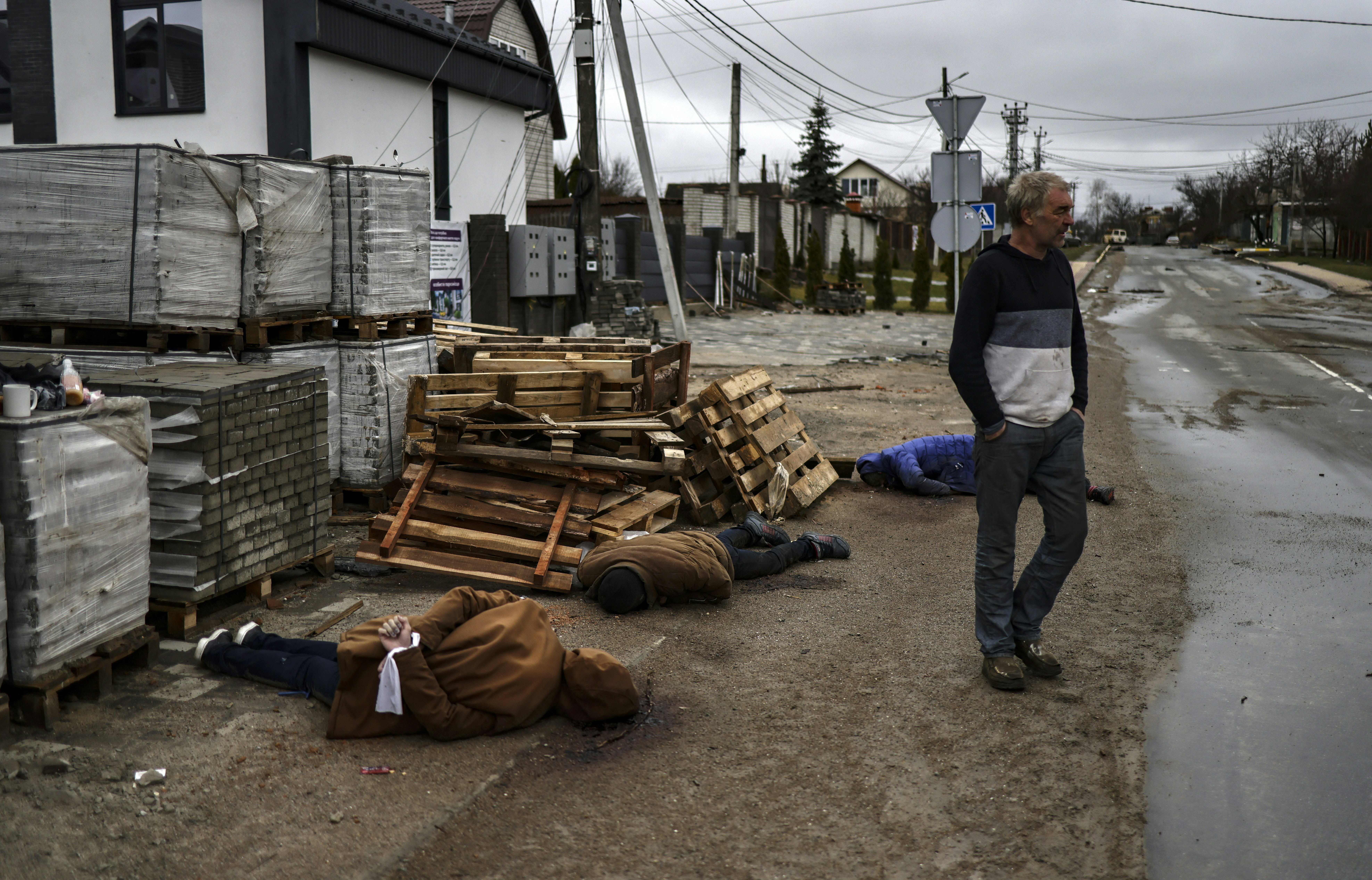
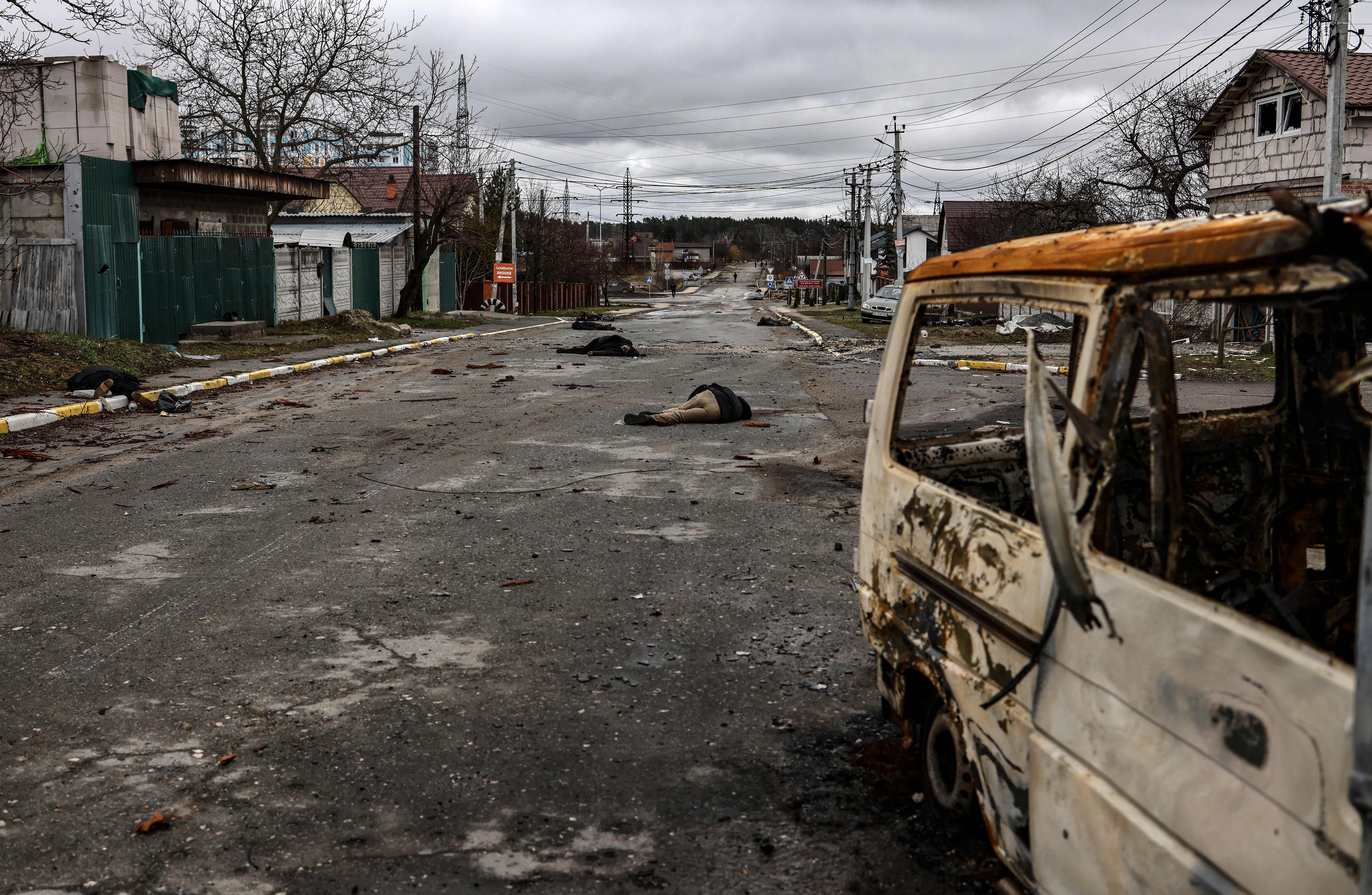
Dead bodies lie on a street in Bucha, northwest of Kyiv, Ukraine on April 2, 2022.Photos: Ronaldo Schemidt/AFP via Getty Images
Journalists from the AP and AFP also recorded video and photographs of dead bodies on Yablonska Street on the afternoon of April 2. Those images were also incorrectly dated April 3 by the producers of “Antifake,” who showed them with the “fake” stamp.
It matters that Russian viewers were repeatedly misled about what date the video from Bucha was recorded because Russia’s Defense Ministry built its case that the crime scene had been staged on the supposed gap between the departure of its forces and the discovery of the bodies.
Smol also showed viewers video Russia’s Defense Ministry had called proof that things were fine in Bucha when its soldiers left: a video statement from Bucha’s mayor, Anatolii Fedoruk, in which he said that March 31 would go down in history as the date the Russian occupation of the city had ended. But Russian officials and “Antifake” incorrectly reported that this video was recorded by the mayor that same day, March 31.
The mayor’s message to Bucha’s citizens was, in fact, posted on the city council’s Facebook page the evening of April 1. And the mayor said that the previous day, March 31, was the day the city was liberated from the Russian occupiers, not March 30.
Russian officials, and state television, said the fact that the mayor made no mention of dead bodies on Bucha’s streets in his brief statement was somehow proof that the victims had not yet been shot. However, another local official did mention the bodies of the dead in a video he posted on the same city Facebook page the morning of April 1.
In that Facebook video, the secretary of Bucha’s city council, Taras Shapravsky, advised residents who had fled Bucha that the town was not yet entirely free of Russian troops. Shapravsky then specifically warned everyone to avoid the corpses on the streets. “Do not touch the bodies of the dead, which have been lying for a long time,” Shapravsky said. “There is a high probability that they are mined.”
Despite this evidence showing that the timeline laid out by Russia’s Defense Ministry is false, Russian officials and state television have continued to mislead the public by claiming that the video of the bodies on Yablonska Street did not appear until Bucha had been back under Ukrainian control for four days.
Russian television has also concealed from viewers that an earlier clip of the bodies on Yablonska Street was uploaded to Instagram the evening of April 1. Copies of that video appeared the same night on Facebook, Telegram, YouTube, and Twitter and quickly went viral.
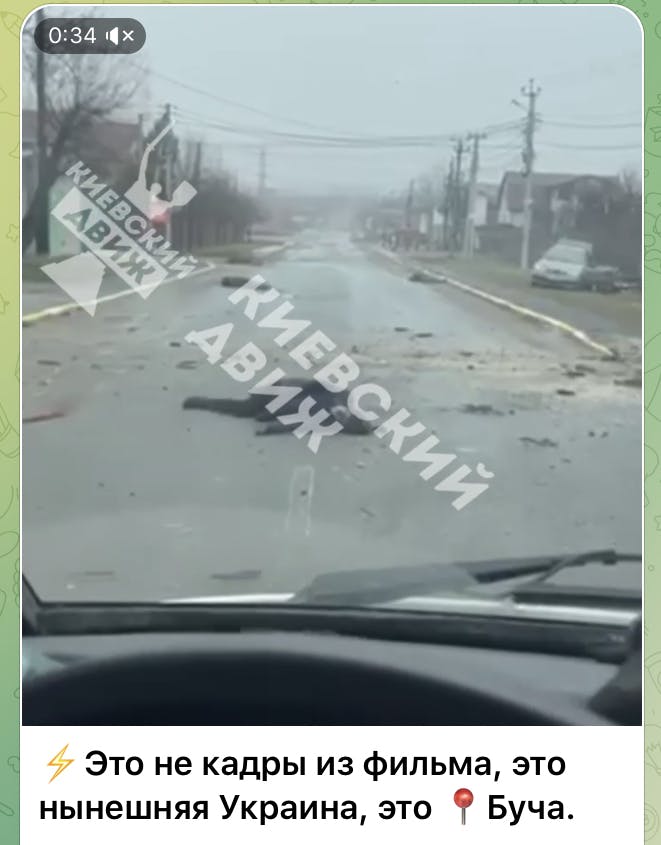
A video of dead bodies on Yablonska Street in Bucha was posted on the Kievskiy Dvizh Telegram channel on April 1, 2022, at 9:48 p.m. local time in Kyiv, Ukraine. The original video appears to have been posted in an Instagram story by a local official from the neighboring city of Irpin who was in Bucha that day.
Photo: Kievskiy Dvizh, via Telegram
While Russian television has obsessively focused on the recording from that street that emerged on April 2, the earlier video shows that this crime scene in Bucha was first recorded the same day the city’s mayor announced that the Russian troops were gone.
The comment at the start of that video, which seems to have been first posted on Instagram by a local government official from the neighboring city of Irpin, conveys a sense of stunned horror from the man recording it. “If you say that Russian soldiers are … humans,” the person filming the bodies says before trailing off.
Meduza, a news organization run by Russian journalists in Latvia, obtained drone footage of Yablonska Street recorded on March 23, during the Russian occupation, and compared it with the video posted online on April 1. Meduza’s visual analysis shows that at least seven of the bodies discovered on the street on April 1 were seen in the same positions on March 23.
As Zakharova’s comments suggested, the Russian government’s response to the evidence that its soldiers committed atrocities in Bucha echoes its response to the evidence that its Syrian allies did so in 2018. Russia has a long track record of promoting what are essentially versions of the same conspiracy theory — that whatever crime its government is implicated in was actually an elaborate hoax set up by its enemies.
That’s how Russian officials, and state television, responded in 2014, when Malaysia Airlines Flight MH17 was shot down over rebel-held eastern Ukraine, killing all 298 people passengers. They told the Russian public a version of the same tale in 2020 when the leading Russian opposition figure, Alexey Navalny, was poisoned with Novichok, a neurotoxin developed in the Soviet Union. Three men with ties to Russian military and intelligence agencies, were later indicted for shooting down MH17 by international prosecutors. After Navalny survived the assassination attempt, he tricked a Russian intelligence agent into admitting that he was part of a team that had tried to kill him.
Last week, an “Antifake” guest, Grigory Pernavsky, argued that the supposed Bucha hoax seemed to echo what Russia still insists was a fake chemical attack in the Syrian town of Douma in 2018. In that case, Russia claimed, incorrectly, that the only evidence of a chemical attack was video of children being doused with water by rescue workers in an area held by Syrian rebels until the next day. (In fact, the main evidence of an attack was video recorded in another location that showed a chlorine gas canister that was dropped on a building where dozens of victims were found.)
This Russian state TV’s “Antifake” claimed that the Bucha massacre was a hoax (it was not) like the chemical attack in the Syrian town of Douma in 2018 was a hoax (it was not). The show’s go-to move is to show viewers real video and stamp it “Fake.” pic.twitter.com/tN7WDBzCQV
— Robert Mackey (@RobertMackey) April 10, 2022
In an effort to shield Syrian government forces from blame for the chemical attack in Douma, Russia’s military and Russian state television claimed, without credible evidence, that Syrian rebels and the Syria Civil Defence, known as the White Helmets, had staged the scene of the children being treated as part of a hoax. As Pernavsky spoke, video of one of those Syrian children, 11-year-old Hassan Diab, being treated for suspected exposure to chemicals appeared on screen and was also stamped “fake.”
Pernavsky claimed that the chemical attack indeed “turned out to be fake” and that “even the Western side is trying not to talk about it anymore.” In fact, an independent investigation of the attack in Douma by experts in chemical warfare from the Organisation for the Prohibition of Chemical Weapons concluded that a toxic chemical, most likely chlorine, was used. James Harkin, the director of the Centre for Investigative Journalism, similarly concluded that a chemical attack did take place in a detailed reconstruction of the attack for The Intercept, and expert analysis of the visual evidence by Forensic Architecture and the New York Times suggested that chlorine gas canisters were dropped from the air in an area where the skies were under the total control of Syria and Russia.
As The Intercept reported in the aftermath of the attack in Douma, after the town came under the control of the Russian military, young Hassan was located and secretly brought to a Syrian military facility to be interviewed by Russian state television war correspondent Evgeny Poddubnyy. Although the boy’s testimony, offered under extraordinary pressure, did not actually show that the chemical attack had been staged, Russian state television claimed that it did.
The boy was then taken by Russian officials to the Hague for a news conference at the headquarters of the Organisation for the Prohibition of Chemical Weapons, where they claimed that his account proved Russia’s case that the attack had been a hoax, staged by the rebels. Russian officials acted as if the video of Hassan and the other children was the only evidence of a chemical attack in Douma, which was entirely untrue. But the myth that the boy’s testimony proved the Russian case has been treated as fact for four years on Russian state television, where the case is repeatedly cited as evidence that Western intelligence is constantly engaged in staging events to frame Russia.
On Monday, Poddubnyy, who was embedded with Russian forces outside Kyiv before their retreat, appeared on a state news channel and falsely claimed that the victims of the Bucha massacre were a mix of actors and civilians killed by Ukrainian soldiers after the Russians withdrew.
Here is what Russian people see on state TV. War correspondent Yevgeny Poddubny is embedded with the Russian troops and may have witnessed their atrocities firsthand. He claims that Ukrainians killed their own people & also used actors to stage a fake production and blame Russia. pic.twitter.com/oAfWxO7yhl
— Julia Davis (@JuliaDavisNews) April 5, 2022
One accidental expert on the persuasive power of Russian state television’s campaign is the jailed opposition leader Alexey Navalny. Cut off from the internet, Navalny reported in a message smuggled out of the prison where he is being held that “an ordinary Russian TV viewer (one of whom I currently am)” was being overwhelmed by disinformation that there had been a “massacre by Ukrainian Nazis in Bucha.”
Navalny described his shock at seeing a news anchor on Russian state television’s main news show report as fact the bizarre speculation that Bucha was chosen as the place to stage a fake massacre because the city’s name sounds like the English word “butcher.”
“I’m telling you,” Navalny commented, “the monstrosity of lies on federal channels is unimaginable. And, unfortunately, so is its persuasiveness for those who have no access to alternative information.”
“The endlessly squealing anchors and their ‘experts’ are revving up their fury and have long since surpassed the military in their aggressiveness,” the jailed anti-corruption activist added. “They demand a war to the bitter end, storming Kyiv, bombing Lviv. Even the prospect of a nuclear war does not scare them. They mop up the floor with their fellow Putinists on live television if they as much as hint at the fact that peace talks are a good thing.”
“It’s such a disgusting uroboros,” Navalny wrote. “Politics is a propaganda snake biting its own tail. Propagandists create the kind of public opinion that no longer simply allows Putin to commit war crimes, but demands them of him.”
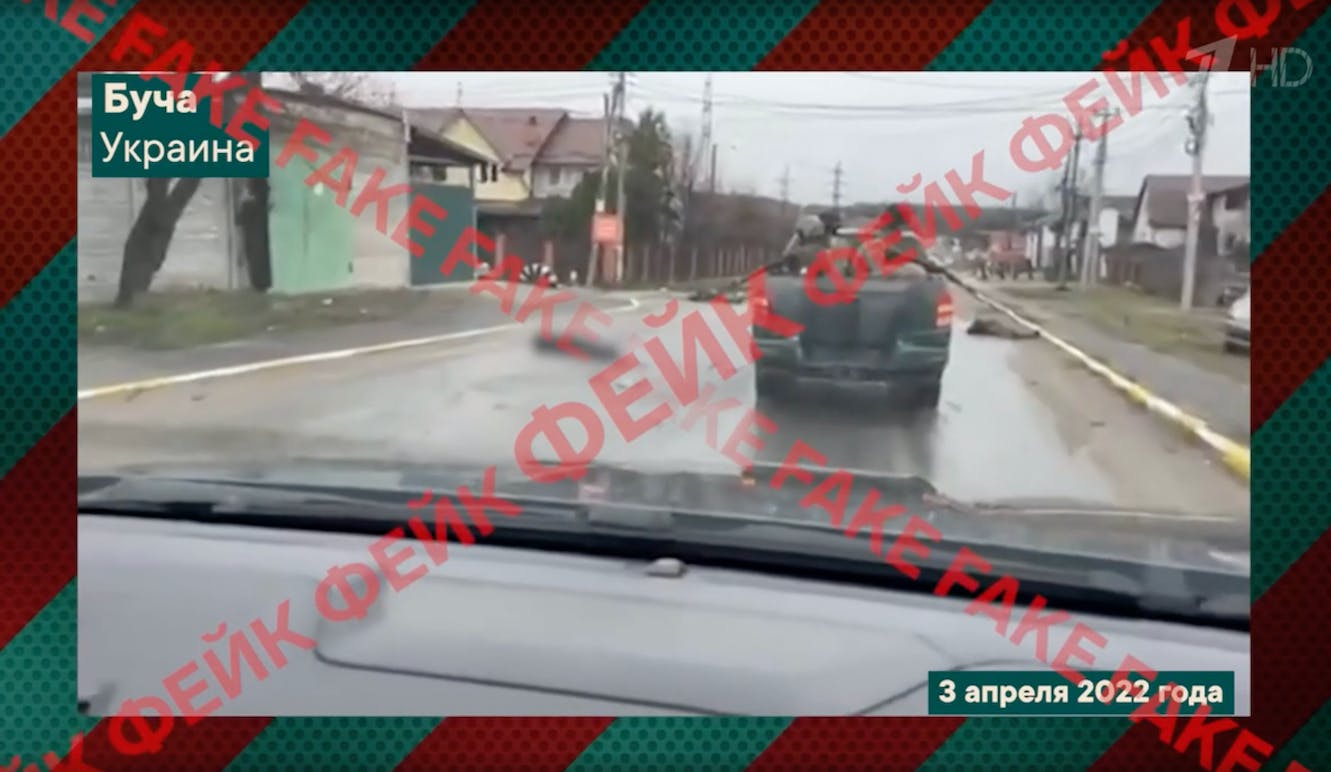
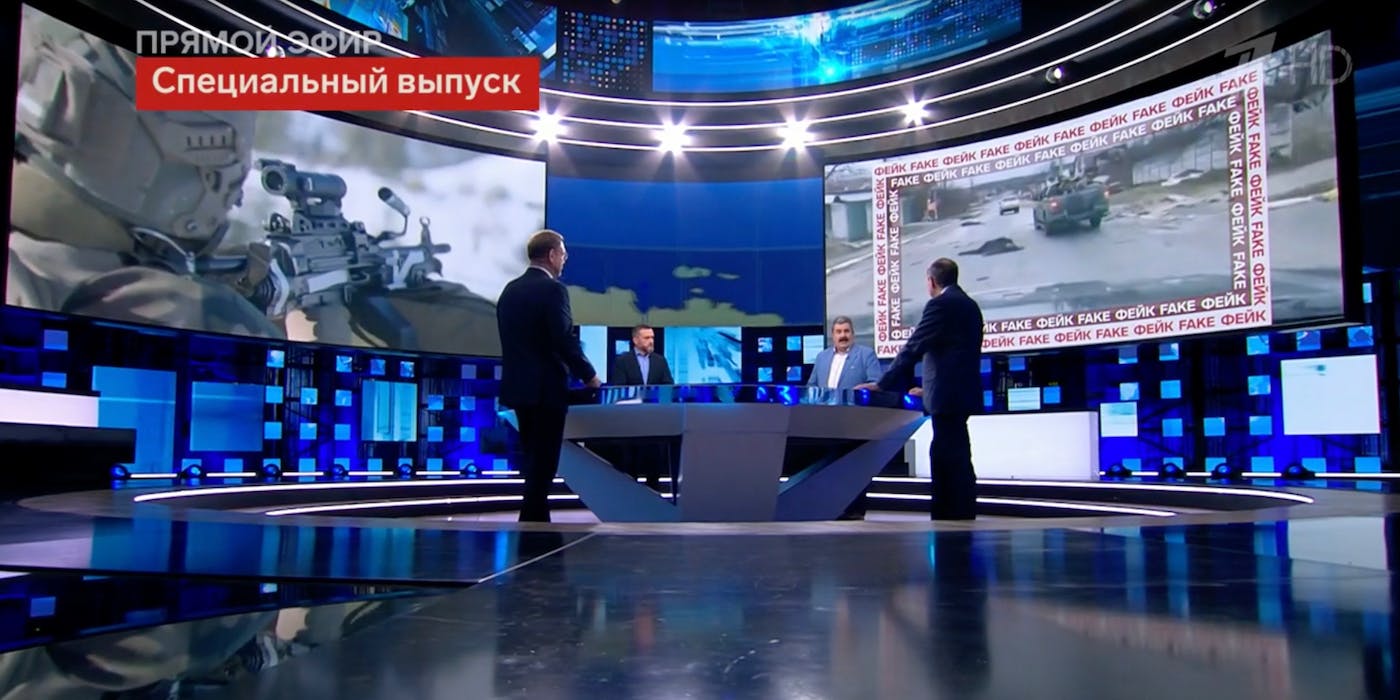
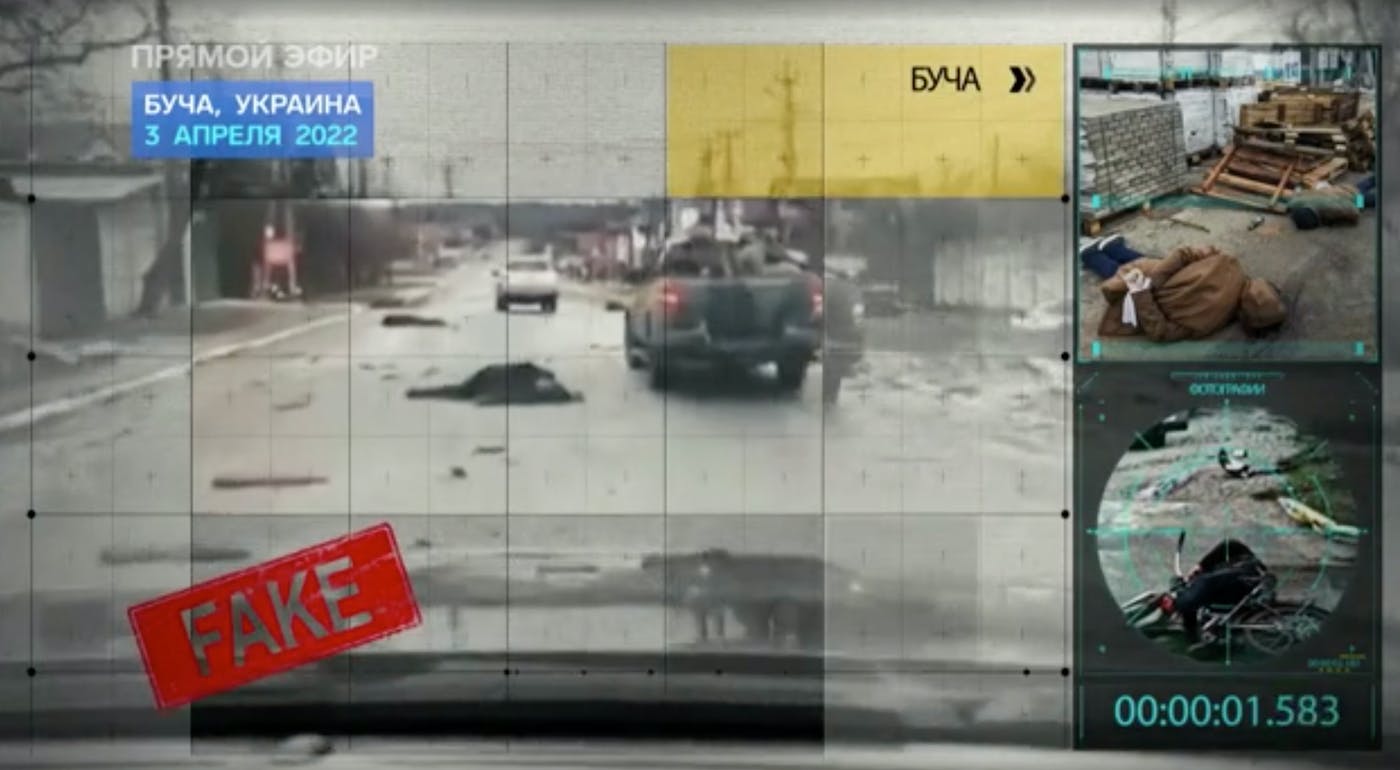
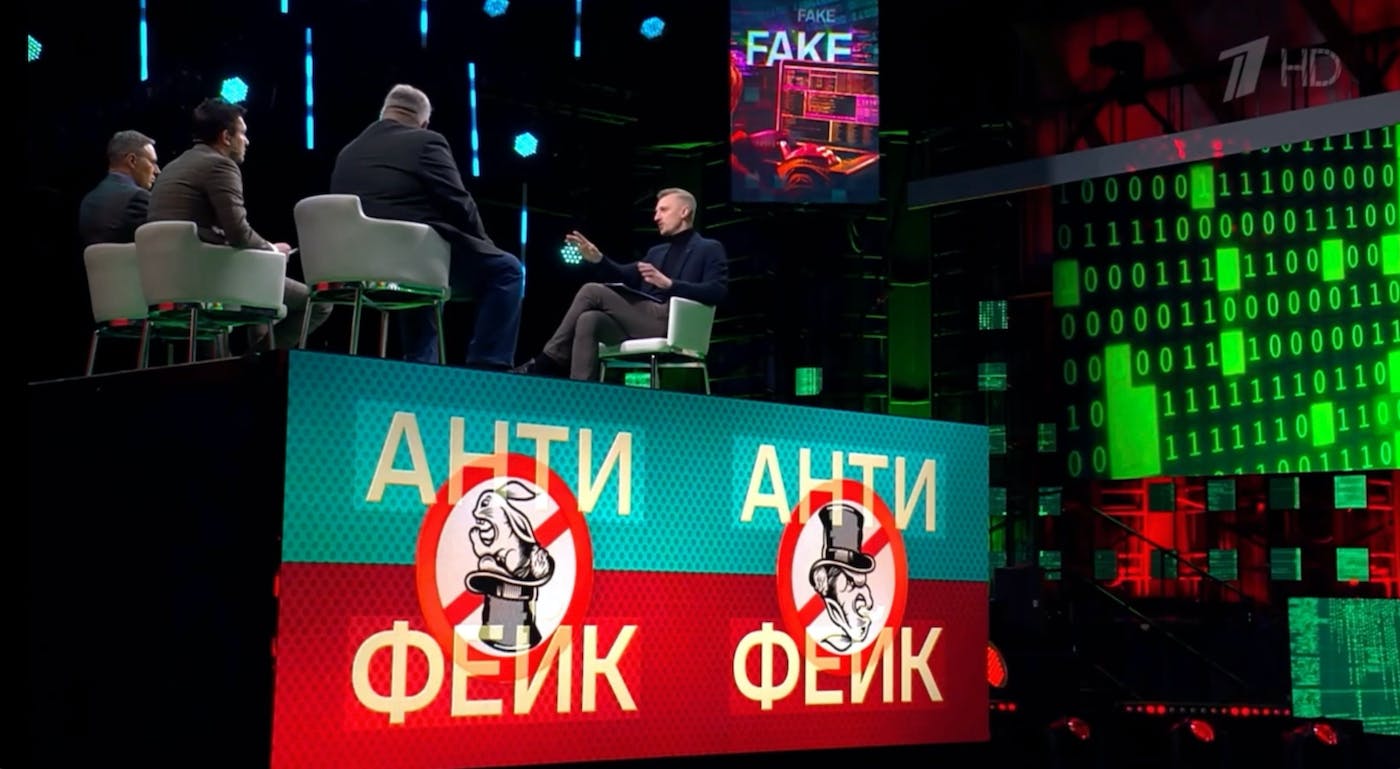
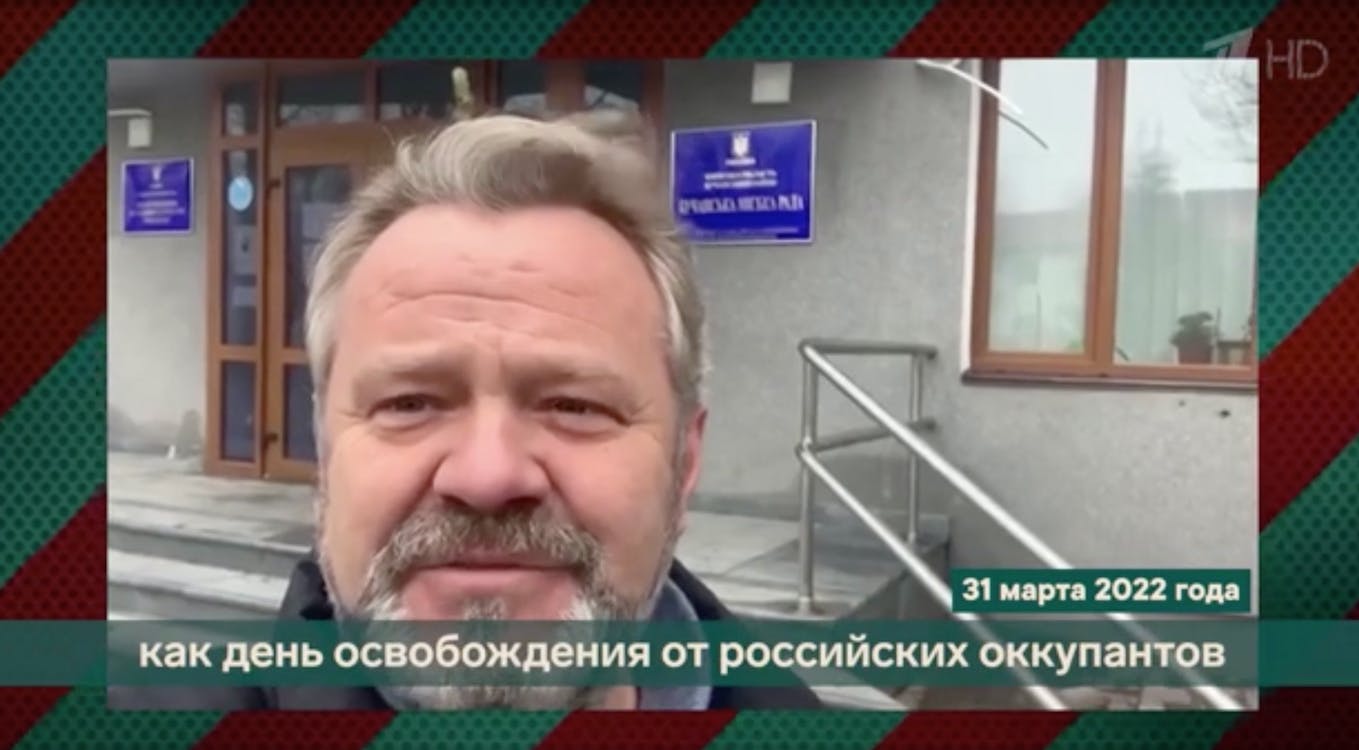
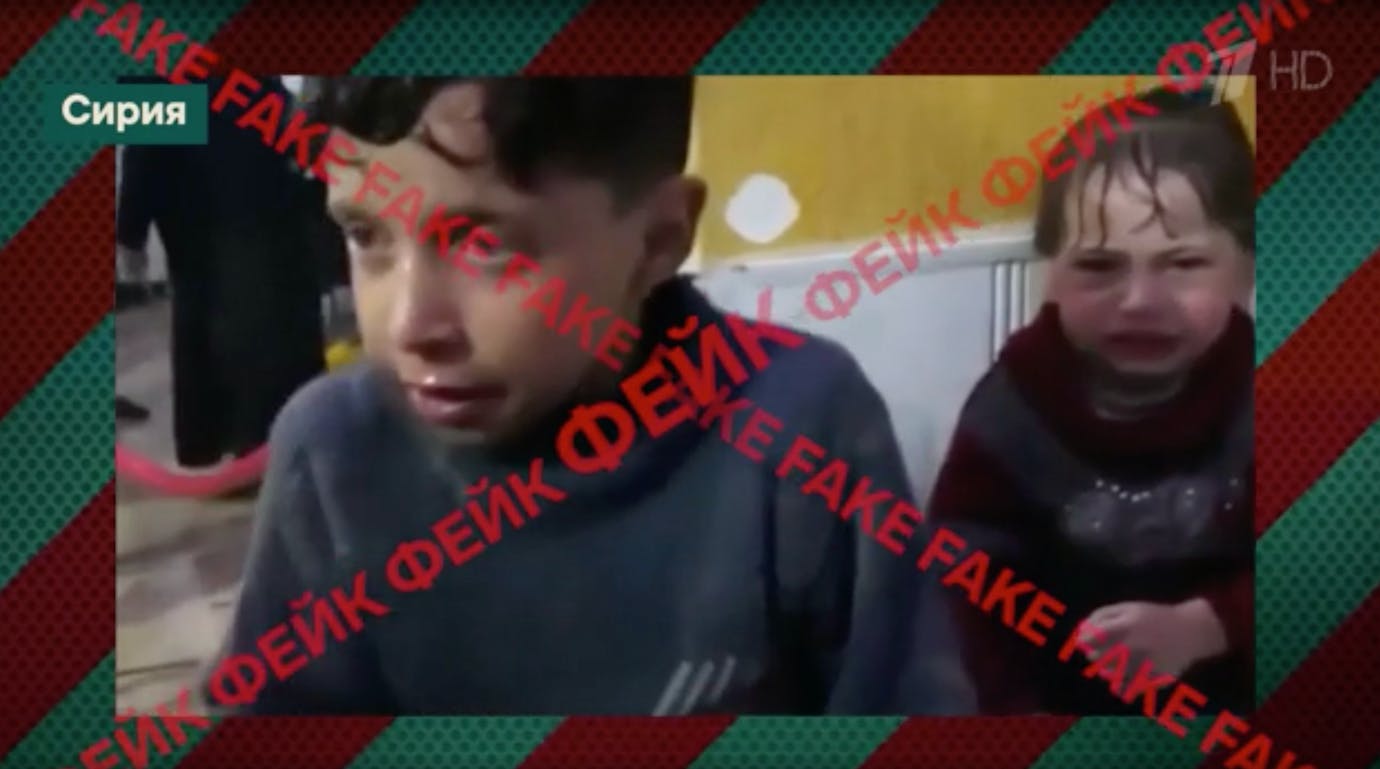

![The Financial Jigsaw Part 2 (47) – THE RULING ELITE – Faith & Reason – FSD – Ukraine SitRep – UK High St, Decline – UK News Flash – Global South Challenge – Who is Kier Starmer? – [06-07-25] The Financial Jigsaw Part 2 (47) – THE RULING ELITE – Faith & Reason – FSD – Ukraine SitRep – UK High St, Decline – UK News Flash – Global South Challenge – Who is Kier Starmer? – [06-07-25]](https://wp.fifu.app/conspiracyresource.com/aHR0cHM6Ly9zdWJzdGFja2Nkbi5jb20vaW1hZ2UvZmV0Y2gvd18xNDU2LGNfbGltaXQsZl9hdXRvLHFfYXV0bzpnb29kLGZsX3Byb2dyZXNzaXZlOnN0ZWVwL2h0dHBzJTNBJTJGJTJGc3Vic3RhY2stcG9zdC1tZWRpYS5zMy5hbWF6b25hd3MuY29tJTJGcHVibGljJTJGaW1hZ2VzJTJGYWQzMmI2ZjktOTg2ZC00MjJhLTlhN2MtZjI4NTgwZWZlNWQzXzk4NHg1NTIucG5n/9c1878938158/the-financial-jigsaw-part-2-47-the-ruling-elite-faith-reason-fsd-ukraine-sitrep-uk-high-st-decline-uk-news-flash-global-s.webp?w=390&h=205&c=0&p=502592)

